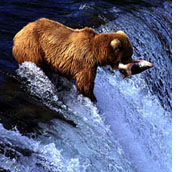
As to the other widespread anomalies mentioned, the coccolithophores are not the primary cause. The study
done on the Pribilof Islands actually provides some evidence that the coccolithophores are not
responsible for the late summer deaths of the shearwaters up and down Alaska's coast. Like the
kittiwakes, shearwaters feed off the surface. Even if the shearwaters venture past their coastal domain
to look for food in the coccolith-infested waters, they should not have a hard time finding their
target. "It’s not clear the coccoliths are doing anything to the shearwater population," said Hunt.
|
|
Shearwater in flight. The deaths of many Bering Sea seabirds in recent years may be
related to the same climatic changes that allow coccolithophores to bloom.
|
|
Another study funded by the National Science Foundation is still underway in part to determine
the cause of the shearwater deaths. So far the researchers involved have learned that the widespread
death of shearwater birds occurred in areas both affected by, and unaffected by, the coccolith bloom,
said Hunt.
They hypothesize that the most probable explanation for shearwater deaths is the widespread warming of
the surface waters in the area. "This has changed the location of the birds’ prey," Hunt said. "In
addition, along the southeastern Bering Sea shelf, a krill-like zooplankton known as a euphausiid
appears to have decreased in number by at least an order of magnitude (multiple of ten)." These
euphausiids are one of the primary sources of food for the shearwaters in coastal waters.
|

Euphasiids (a
species of krill about 2cm from end to end) feed on large diatoms, instead of the smaller armored
coccolithophores. With the displacement of diatoms by coccolithophores, euphasiid populations have been
declining rapidly. (Photograph copyright Steven Haddock)
|

Salmon and other predatory fish also devour the euphausiids. So the drop in the population of these large
zooplankton near the coastal areas, may be part of the reason the salmon failed to return to the rivers
of western Alaska, said Hunt. According to the NOAA report (Brodeur et al. 1998), the salmon populations
over the past two summers fell 53 percent below what was expected, putting many fisheries out of
business. In addition, more salmon are being found off the coast of Siberia and on Alaska’s southern
shores outside the Bering Sea. The salmon that do return to western Alaska vary in age and strength. In
earlier years with low turnout, the healthier, larger salmon would normally make up the majority of the
returning fish.
The disappearance of the zooplankton probably isn’t the only reason the
fish counts are down and the birds are dying, but the disappearance contributes to the problem. Steve
Zeeman, a biological oceanographer at the University of Maine and a colleague of William Balch,
explained that the disappearance of the zooplankton has to do with size. The diatoms that usually
dominate the shelf are quite a bit larger than the coccolithophores. Since larger microscopic animals
like euphausiids survive by feeding on larger one-celled plants like diatoms, the absence of the plant
will cause a drop in the animal population. "And we then see a decline of wildlife along the food
chain," said Zeeman. His conjecture is supported by the NOAA report (Napp et al. 1998), which states
that the short-term change in zooplankton coincides with the change in the Bering Sea’s
phytoplankton.
 Final
Thoughts Final
Thoughts
 A Blinding
Sight for Some Seabirds A Blinding
Sight for Some Seabirds
|
Salmon, seabirds, and some marine
animals eat euphausiids. As the krill populations crashed, animals higher up in the food chain also
suffered. This bear grabbing lunch from an Alaskan stream represents the wide ranging impact of a
microscopic plant. In addition to its effects on wildlife, environmental change also impacts human
communities that rely on natural resources. (Photograph copyright Lon Overacker)
|

